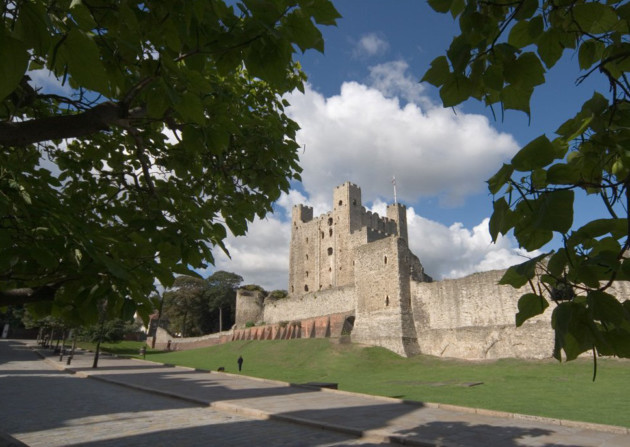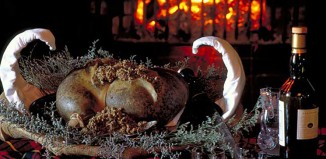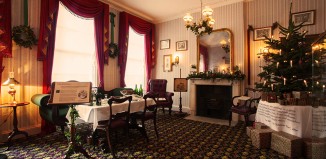Rochester
Jo Leevers
If there’s one historic figure who will be forever be associated with Rochester, it is Charles Dickens. The maze of alleyways and the high street’s jumble of timber and weatherboard buildings are amply evocative of his novels, but to ensure you don’t forget, a host of shop and restaurant names remind you of his legacy at every turn. Where else would you find Tiny Tim’s Tearoom, Copperfield’s, Ebenezer’s gift shop, Peggotty’s Parlour and Sweet Expectations all lining one street? There’s even a Taste of Two Cities Indian restaurant.
But the good news is that there is far more to a visit to Rochester than paying homage to the great Victorian novelist. While the annual summer Dickens Festival of costumed parades and performances is a highlight of the local calendar, the city had amassed a rich and varied history long before the writer was born in nearby Chatham.
Rochester has been a significant stop for travellers of all kinds for over 2,000 years. Its location in the north of Kent, at the lowest point of the river Medway, meant it occupied a key strategic position from Roman times right up until the Second World War, a role that has left it with a fascinatingly rugged character ¬- perfect for those who like to rediscover the forgotten stories of a once vital centre.
‘The beauty of Rochester,” says Ed Woollard, Tourism Development Officer for the Medway area, ‘is that it is not only bursting with history, but its centre is compact. It’s very easy to get around on foot so the first-time visitor can get a real sense of its heritage.’ With a Norman castle and the second oldest cathedral in Britain – not to mention those links with Charles Dickens – it’s ripe for exploring.
The station and main car parks are a short walk from the high street, which once formed part of a Roman road from London to the Kent coast and beyond to France. Ed Woollard fills us in: “There was a settlement here well before the Romans arrived, and the occupiers immediately saw why: at the lowest point of Medway it provided the easiest route for troops or merchants moving between London and Dover.”
Rochester Castle looms over the top end of the high street. Rochester was one of the first settlements to be fortified by the Normans after 1066 – a testament to its enduring strategic position. Ed Woollard adds, “The keep looks every inch the ‘archetypal castle’ and is among the tallest remaining in Britain.”
The first fortification to stand on this spot was a rough and ready construction of earthworks and timber, but in 1087, Bishop Gundulf – William the Conqueror’s best architect – initiated a fortress in more durable stone. It did not gain its imposing keep until 1127 under the auspices of Archbishop William de Corbeil. Even today the 113ft (34m) high walls, which are up to 12ft (3.8m) thick, are a daunting sight.
In 1215 the castle was garrisoned by rebel bishops, and besieged by King John, brother to Richard the Lionheart. A tunnel was dug under the wall of the southeast tower of the keep, and a fire was lit, stoked by the fat of 40 pigs. The fat-fuelled flames burned through both the tunnel’s timber supports and then the tower. Even then, the defenders held out for another two months before being starved out.
A climb to the top is a breathtaking, wind-buffeted experience, with spectacular views of the cathedral and the river. You get a graphic impression of the Medway’s industrial and maritime past, and the boats that must have traversed its waters, going to and from the Historic Dockyard at Chatham just along the river.
If the view of the cathedral has whet your appetite, leave the castle grounds by the small gate behind the keep and turn left. From here, the west façade of Rochester Cathedral rises up as an impressive example of Norman architecture, with the portal depicting angels and symbols of the four apostles. Building began in 1080 under Bishop Gundulf, who was also responsible for the White Tower at the Tower of London. Standing in the Norman nave, the scale of the project and the craftsmanship are quite inspiring.
It’s worth taking time to look at the Norman pillars as every pair is different, each stone mason leaving his mark so the master mason could check the quality of his work and determine his pay. The pillars would once have been decorated with sketches of Bible stories that acted as a ‘poor man’s bible’ for the illiterate congregation.
The low nave contrasts dramatically with the soaring Gothic arches in the centre of the cathedral. Rochester Cathedral is notable for having the first fresco painted in an English cathedral in 800 years. Commissioned in 1999, Russian iconographer Sergei Fyodorov’s baptism-themed fresco was painted directly onto a special mix of wet plaster to endure for future generations.
Outside, the Cloister Garth is a quiet garden amid the ruins of the Norman priory, which, upon the dissolution of the monasteries, was retained as a royal stopping place between London and the coast. It is said that Henry VIII came here in disguise to sneak a first glimpse of Anne of Cleves as she rested en route from the continent. He had brought gifts, but was so unimpressed by her that he took his presents and left – not an auspicious start to his fourth marriage which was, of course, swiftly annulled.
Retrace your steps back to the cathedral’s west entrance, turning left onto Minor Canon Row, a fine terrace built for the less prestigious clergy in 1723, and buildings belonging to King’s school, including the Grade II listed Oriel House, with interesting firemarks on the façade. These signified which company had insured the property against fire.
Continuing through The Vines, once a monks’ vineyard and now a pretty place to rest awhile, you come to Restoration House. It was named in honour of Charles II, who stayed here on his return to England in 1660 before travelling on to London to reclaim the throne. It was most famously used by Charles Dickens as the model for Satis House, home to Miss Havisham and Estelle in Great Expectations.
The house’s ivy-clad, rather foreboding exterior inspired Dickens, and some of that ‘Miss Havisham’ atmosphere still lingers. The house is owned by Robert Tucker and Jonathan Willmot, who are passionate about the building’s history. The Dickens connection brings many visitors to its doors, but once they step inside, people discover that Restoration House had a rich history before Dickens even glimpsed its beautiful façade. Decorative flourishes with a continental flavour created to welcome Charles II – such as Japanned furniture and marbling – have been carefully restored. An art collection includes Reynolds, Constable and Gainsborough, alongside fine examples of 17th and 18th century furniture. The house and gardens are open from June to September.
Back on the high street, two museums help complete the full story of Rochester’s past. The 16th century stone building at number 87 is The Poor Travellers House. It was an almshouse bequeathed by one Richard Watts MP in 1579 to be used as overnight shelter for those with nowhere else to go. A stone inscription over the door, added in 1865, reads: “For six poor travellers who not being rogues or proctors may receive gratis for one night lodging, entertainment and four pence each”. The four pence was because The Poor Law Act of 1576 stated that anyone with less was classed as a vagrant and could be whipped and returned to their own parish. “Proctors” were unscrupulous beggars, while “rogues” speak for themselves. The simply furnished rooms give a sobering picture of life for the underclasses over the centuries. The museum is free and open Wednesday to Sunday, 11am-2pm, March to October.
At the top of the high street you’ll find The Guildhall Museum, also free, with a Dickens Discovery Room and more surprising vignettes from Rochester’s history. “There’s a particularly interesting account of the notorious hulk ships, floating prisons that were anchored in the Medway in the Napoleonic era,” says Ed Woollard. “Despite abhorrent conditions, inmates occupied themselves by creating intricate objects from hair, bone and wood. These unusual artefacts make a fascinating display.’
With a little searching, unexpected and captivating stories of Kentish history can be unearthed from Rochester’s hidden past. Dickens, that great lover of intriguing tales, would have heartily approved.
www.visitmedway.org








